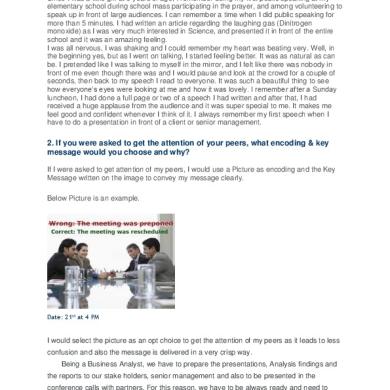Some Basic Definitions.docx
This document was uploaded by user and they confirmed that they have the permission to share it. If you are author or own the copyright of this book, please report to us by using this DMCA report form. Report DMCA
Overview
Download & View Some Basic Definitions.docx as PDF for free.
More details
- Words: 404
- Pages: 2
SOME BASIC DEFINITIONS (i) Variate: Variate is a quantity that may vary from observation to observation. (ii) Range: Range is difference between the maximum and minimum observations. (iii) Class Interval: When data are divided in groups, each group is called a class interval. (iv) Class Limit: Every class interval has two limits. The smallest observation of the interval is called lower limit and the largest observation of the interval is called upper limit. (v) Class Mark: The mid value of any class is called its class mark. Class Mark = Upper limit of the class + lower limit of the class 2 (vi) Class Size: Class size is defined as the difference between two successive class marks. It is also the difference between the upper and lower limits of any class interval. (vii)
Frequency: In a particular class the count of the number of observation is
called its frequency. So the corresponding frequency of a class is called its class frequency. (viii)
Cumulative Frequency: The cumulative frequency of any class is obtained
by adding all the frequencies successively prior to that class i.e. it is the sum of all frequencies up to that class. Inclusive and Exclusive distributions: Inclusive Distribution : When in a distribution, the upper limit does not coincide with the lower limit of the next class then the distribution is called an inclusive distribution. e.g. Inclusive Form Height (in cm)
No. of Students
150-152
4
153-156
10
157-169
6
170-173
3
Exclusive Distribution: An exclusive distribution is that distribution in which the upper limit of one class coincides with the lower limit of the next class. e.g. Inclusive Form Height (in years)
No. of Students
10-20
10
20-30
8
30-40
15
40-50
4
True Class Limit: In the case of exclusive classes the upper and lower limits are respectively known as its true upper limits and true lower limits. In the case of inclusive classes, the true lower and upper limits are obtained by subtracting 0.5 from the lower limit and adding 0.5 to the upper limit. True upper limits and true lower limits are also known as boundaries of the class. Tally: Tally method is used to keep the chance of error at minimum in counting. A bar (|) called tally mark is put against any item when it occurs. The fifth occurrence of any item is represented by putting diagonally a cross tally (|) on the first four tallies.
Frequency: In a particular class the count of the number of observation is
called its frequency. So the corresponding frequency of a class is called its class frequency. (viii)
Cumulative Frequency: The cumulative frequency of any class is obtained
by adding all the frequencies successively prior to that class i.e. it is the sum of all frequencies up to that class. Inclusive and Exclusive distributions: Inclusive Distribution : When in a distribution, the upper limit does not coincide with the lower limit of the next class then the distribution is called an inclusive distribution. e.g. Inclusive Form Height (in cm)
No. of Students
150-152
4
153-156
10
157-169
6
170-173
3
Exclusive Distribution: An exclusive distribution is that distribution in which the upper limit of one class coincides with the lower limit of the next class. e.g. Inclusive Form Height (in years)
No. of Students
10-20
10
20-30
8
30-40
15
40-50
4
True Class Limit: In the case of exclusive classes the upper and lower limits are respectively known as its true upper limits and true lower limits. In the case of inclusive classes, the true lower and upper limits are obtained by subtracting 0.5 from the lower limit and adding 0.5 to the upper limit. True upper limits and true lower limits are also known as boundaries of the class. Tally: Tally method is used to keep the chance of error at minimum in counting. A bar (|) called tally mark is put against any item when it occurs. The fifth occurrence of any item is represented by putting diagonally a cross tally (|) on the first four tallies.
Related Documents

Some Basic Definitions.docx
November 2019 10
Some
December 2019 34
Some
October 2019 27
Some
May 2020 16
Educational Research: Some Basic Concepts And Terminology
October 2019 16
Some Basic Cencept Of Analog Communication
December 2019 10More Documents from "Vikas Chandra"

Assignment (pa).docx
November 2019 14
Descriptive Statistics.docx
November 2019 24
Assignment 1.docx
November 2019 16
Introduction To Statistics.docx
November 2019 15
Assignment 2.docx
November 2019 16